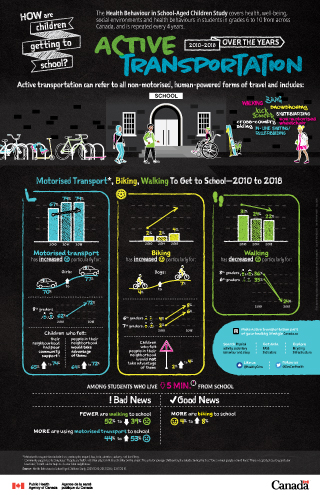Active transportation in children over the years, 2010 -2018

Download the alternative format
(PDF format, 5.6 MB, 1 page)
- Organization: Public Health Agency of Canada
- Date published: January 2023
The Health Behaviour in School-Aged Children Study covers health, well-being, social environments and health behaviours in students in grades 6 to 10 from across Canada, and is repeated every 4 years.
Active transportation can refer to all non-motorised, human-powered forms of travel and includes:
- Walking
- Biking
- Kick scooters
- Snowshoeing
- Skateboarding
- Non-motorised wheelchair
- Cross-country skiing
- In-line skating/rollerblading
Motorised TransportFootnote *, Biking, Walking To Get to School—2010 to 2018
Overall, between 2010 and 2018, the use of motorised transport to get to school has increased from 67% to 74%, and particularly for:
- Girls, from 70% to 77% (there was no change for boys)
- 8th graders, from 62% to 72% (there were no changes for 6th, 7th, 9th and 10th graders)
Overall, between 2010 and 2018, biking to school has increased from 2% to 4%, and particularly for:
- Boys, from 4% to 7% (there was no change for girls)
- 6th graders, from 4% to 8%, and 7th graders, from 2% to 6% (there were no changes for 8th, 9th and 10th graders)
Overall, between 2010 and 2018, walking to school has decreased from 31% to 22%, and particularly for:
- 6th graders, from 35% to 24%, and 8th graders, from 36% to 24% (there were no changes for 7th, 9th and 10th graders)
Among students who live less than 5 minutes from school
The good news:
- More are biking to school (an increase from 4% to 8%)
The bad news:
- Fewer are walking to school (a decrease from 52% to 39%)
- More are using motorised transport (an increase from 44% to 53%)
Make active transportation part of your healthy lifestyle
Learn more about active transportation at Canada.ca
- Search Physical activity, sedentary behaviour and sleep
- Get data PASS indicators
- Explore Bicycling Infrastructure
- Like us on Facebook at Healthy Canadians
- Follow us on Twitter at @GovCanHeath
Data source: Health Behaviour in School Aged Children Study, 2009/2010; 2013/2014; 2017/2018.
Page details
- Date modified: